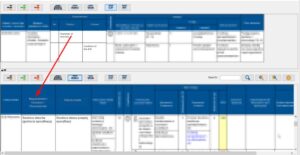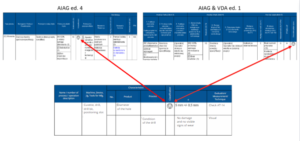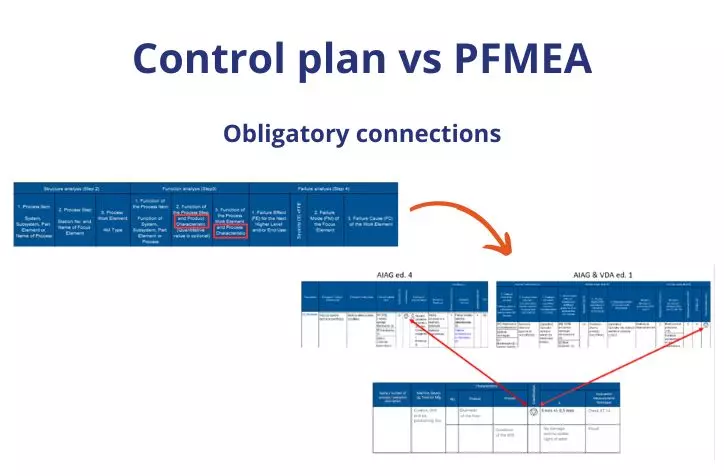Introduction
It may be considered unnecessary to repeat once again that the control plan (CP) is a document created on the basis of the PFMEA, but as one reviews the way these documents are worked on in different companies, it is probably worthwhile (again) to sort out this topic. This is because it seems that companies in which CP and PFMEA are created in parallel and uncontacted teams are doomed to failure in advance. The consequences of this will appear at best on the first good audit, and at worst on the first complaint.
Characteristics of the product and process
The control plan and PFMEA are documents that have completely different objectives, which means they also have different content. However, there are several elements that need to be “synchronized.” Let’s look at it first from the perspective of the control plan.

Control plan: columns for entering characteristics (example from PQ-FMEA+ program).
Product and process characteristics – this element of the control plan is the cause of a great many failures. And it’s not just mistakes that are of some academic nature, but failures that lead to ineffective process control!
First, it is necessary to have a good understanding of the assumed content of these columns. Many people read the headings “Product” and “Process” in isolation from what is above, namely the word “Characteristics.” What is at issue here, then, in order, is not the name of the product (e.g., shock absorber), but the product characteristic under analysis (e.g., bore diameter). It is also about, in the next column, not the name of the process (e.g., drilling), but the name of the process characteristic (e.g., drill size).
In such a context, the connection to PFMEA already seems obvious, especially in the case of a risk analysis conducted in accordance with the AIAG & VDA ed. 1 standard (although this can also be seen, of course, in connection with other forms of this document) – more on this below.
Control plan vs PFMEA compliant with AIAG ed. 4
The AIAG standard ed. 4 did not explicitly require documentation of either product or process characteristics, although not explicitly product characteristics could be gleaned from the “Requirement” column:

Relating CP vs PFMEA product characteristics AIAG ed. 4 (example from the PQ-FMEA+ program).
Thus, the connections should be between requirements from PFMEA and product characteristics from CP. For example: requirement – “Diameter of holes in accordance with the specification”, product characteristics “Diameter of the hole”.
The second connection is between cause and process characteristics. It requires, of course, a certain change in content (because the cause is described as something negative, and the process characteristics are neutral), but it is not difficult. For example: the cause – “Worn drill”, the process characteristics “Condition of the drill”.
Control plan vs PFMEA in accordance with AIAG & VDA ed. 1
It is much simpler to relate the “new” PFMEA to the control plan. After all, working on the basis of the AIAG & VDA ed. 1 standard, in step 3 we actually directly define the product and process characteristics. This is even mapped in the header of the PFMEA form:

The place of entering characteristics in the PFMEA form – step 3 (example from PQ-FMEA+ program).
Even if the grammatical syntax of the descriptions placed in the PFMEA is not identical to those in the control plan, they can easily be related. For example, in the context of product characteristics: description of the function in PFMEA (step 3) “Hole diameter in accordance with the specification” – control plan product characteristics “Hole diameter”. In the context of the process: description of the function referred to 4M in PFMEA (step 3) “Setting the workpiece in the specified position before machining” – control plan process characteristic “Workpiece position before machining”.
Special characteristics
Quite an obvious connection takes place in terms of special characteristics. This is because both documents have a separate (dedicated) column for them:

Related fields for the designation of special characteristics (example from PQ-FMEA+ program).
Thus, if in the PFMEA the special characteristic follows from the description of the requirement and the defect – the product characteristics in the CP should have the special characteristic in question labeled. If in the PFMEA the special characteristic relates to the cause of the defect – in the control plan the special characteristic should be copied to the process characteristic.
How to supervise the characteristics
Another connection relates to how supervision of selected characteristics is planned. In the PFMEA analysis, detection methods are added to each defect (i.e., product characteristic) and cause (i.e., process characteristic), where it turns out to be necessary (due to the level of risk) and DET values are added to them – consistent with the scale used in the company.
Often explicitly the content describing the control is transferred to the CP to the column “Control method” – e.g. “Visual inspection on the bench”, “Automatic inspection within EOL”. This is an option of sorts, but it is absolutely obligatory to link the description from the PFMEA to the “Measurement system” column. Thus, if the PFMEA specifies the control method “Measurement at the workstation” – “Electronic caliper” or “Gauge” or “Micrometer screw” etc. should appear in CP, for example. If we have “Automatic control at the end of the process” entered in PFMEA. – in CP should appear, for example, “ABC leak tester” .
Logic of supervising characteristics
The connection, not explicitly between PFMEA and CP, is the logic of how the characteristics are supervised. This is not a matter of simply transferring the inspection method (as discussed above), but of using the PFMEA team’s findings to determine the appropriate inspection frequency.
This is because if the analysis shows that the only cause of the defect (i.e., consequently, the failure to achieve the product characteristics) is some fixed, permanent cause (e.g., the operator installed a drill of incompatible size), then the inspection of one (first) piece is quite sufficient (the incompatibility will be from the beginning of production). However, if the PFMEA indicates that the cause is random – e.g., the operator placed the drilled part in an incompatible position (every other drill), then inspection of only the first piece makes very, very limited sense.
Summary
As you can see, there is no doubt that the two documents are very much related and a well-done PFMEA already gives us several dozen percent of the content of the control plan. Some programs that specialize in PFMEA (e.g. PQ-FMEA+) therefore create both documents simultaneously themselves (often to the positive surprise of users). Then, after making a good PFMEA in the control plan, all that is left is to add the sample size and frequency, as well as the method of response (the last column of the CP) and we have both documents ready, and most importantly, 100% consistent.



Leave A Comment
You must be logged in to post a comment.